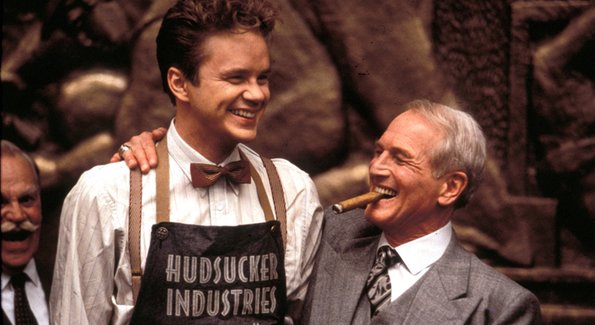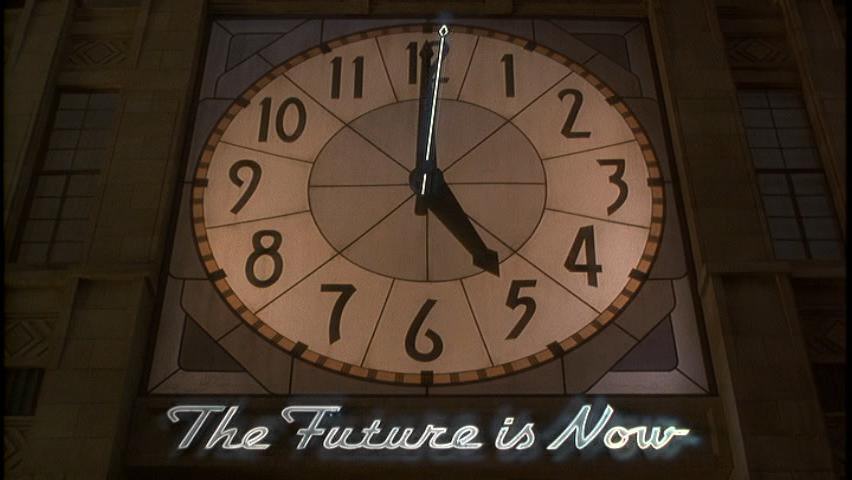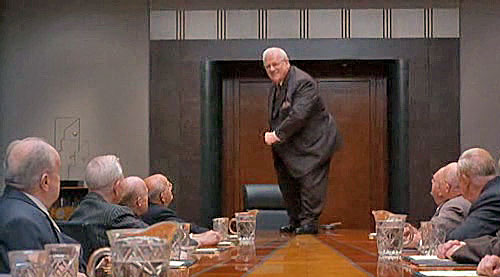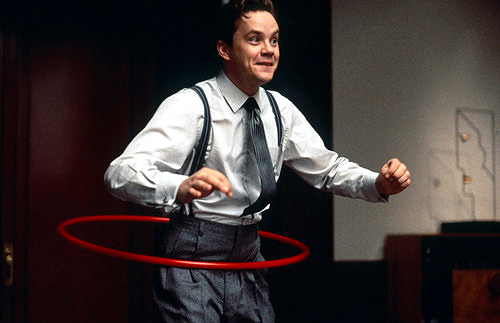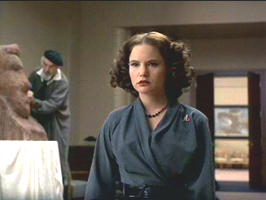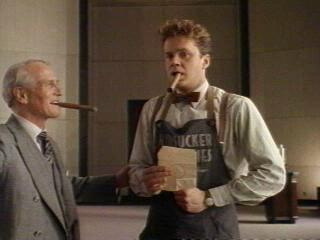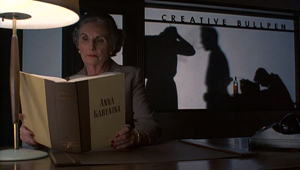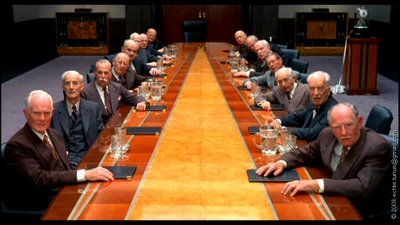From the April 1, 1994 Chicago Reader. — J.R.
* THE HUDSUCKER PROXY
(Has redeeming facet)
Directed by Joel Coen
Written by Ethan Coen, Joel Coen, and Sam Raimi
With Tim Robbins, Jennifer Jason Leigh, Paul Newman, Charles Durning, John Mahoney, Jim True, and William Cobbs.
A black man called Moses but who might as well be named Rastus serves as the narrator for the opening and closing segments of Ethan and Joel Coen’s The Hudsucker Proxy. A janitor type who takes care of the giant clock near the top of the Hudsucker Industries building, an art-deco skyscraper in midtown Manhattan, Moses (William Cobbs) knows everything of importance there is to know about Hudsucker Industries, including all of its secrets. And in case you’re wondering how he knows, the Coen brothers have a ready answer: this is Hollywood, and like every other figure in the movie, Moses is a Hollywood cliché. In old-fashioned studio pictures, black janitors or clock tenders with names like Moses are chock-full of down-home wisdom as well as concrete information about what all those funny white folks is doing.
Resurrecting a racial stereotype like Moses for a 90s comedy may sound dubious, but I suspect the Coens would have an answer to that as well. They might say that Moses is the closest thing to God in this picture, a fact that presumably validates his role (even if it doesn’t in, say, a 30s war-horse like Green Pastures, which harbors comparable conceits about blacks — after all, goes the argument, today we’re hip and smart enough to see through such dated stereotypes). And Moses is godlike not just because he’s the narrator but because of his role in the plot. At the movie’s climax, when the hero and current Hudsucker president, Norville Barnes, is following in the footsteps of the former president, Waring Hudsucker, by leaping off the building’s 45th floor, Moses stops the clock and thereby stops Barnes’s fall in midair, allowing for a scene between Barnes and Hudsucker, who turns up as an angel to convey a few important plot points.
The only other lowly Hudsucker employee who shares some of Moses’ metaphysical nature is a bald, white, cadaverous figure named Aloysius. Clearly signifying Death, he paints the names on the doors of the executive offices whenever someone moves up or down the corporate ladder. When Moses stops the clock and saves Barnes’s life, Aloysius gets in a fist fight with him in order to get the clock started again and send Barnes crashing to his death — to become, as one character noted of Hudsucker after his leap, “abstract art on Madison Avenue.” But when the clock does start up again, Barnes doesn’t crash to his death or become abstract art when he hits the pavement. Why should he? After all, this is a Coen brothers movie, where anything can happen. And however formalistic their aims may be, the Coen brothers show about as much interest in abstract art as they do in the period when this movie is supposed to be taking place, 1958 and 1959.
“The film is strange in that it has to do with a specific era,” Ethan Coen has said, “but it’s not necessary to have historical accuracy in it. The men’s clothes reflect the 30s and 40s. It all has to do with what looks right for the story.” If you’re wondering what “right” could mean in this context, the only explanation seems to be that it’s whatever the Coen brothers, the Beavis and Butt-head of the new American independents, happen to like at any given moment — whatever might make them exclaim, “Yeah, right, cool.” Just as they feel free to invent and then reinvent their own metaphysical rules, proving that they’re smarter than any universe they happen to think up, so they’re also better than history, including all the other universes that other eras — not to mention other filmmakers — have come up with. You might say that this makes them cosmically cool, cooler than all the people who lived before them and cooler than all the members of the audience, who can’t possibly understand all the carefully worked out standards of coolness that the Coens have adopted for this picture. Moses may be God in their game plan, but I guess we have to assume that the Coens are even cooler than God, because their game plan ultimately supplants His.
I suppose I wouldn’t be this exasperated if the Coens didn’t keep expressing more contempt for period verisimilitude from one picture to the next — from the anachronistic dialogue in Miller’s Crossing, set in 1929, to the needlessly demeaning caricatures of Clifford Odets and William Faulkner in Barton Fink, to the depiction of 1958 here, where people dress in 30s clothes and go to 40s diners while speaking every which way. If cartoony silliness was their aim, why couldn’t they have looked at 50s cartoons a little more and 30s and 40s comedies a little less?
Leaving aside for the moment what looks “right” for this story, what is the story? Despite the fact that business is booming at Hudsucker Industries in late 1958, Waring Hudsucker (Charles Durning) climbs onto the table during a board meeting on the 45th floor and, without any explanation, leaps through the plate-glass window to his death. (Presumably the omniscient Moses decides to let him go splat.) At exactly the same time Norville Barnes (Tim Robbins), an eager hayseed just off the bus from Muncie, has by divine intervention — specifically, a gust of wind created by Hudsucker’s leap — discovered a classified ad for a job as a delivery boy at Hudsucker, which he applies for and gets. He has his own industrial scheme, represented by a drawing of a circle and the cryptic line, “You know — for kids”; eventually we discover that what he has in mind is the hula hoop, a toy that actually became a national craze in the 50s, though not in the way shown here. Meanwhile Hudsucker vice president Sidney J. Mussburger (Paul Newman) has discovered that company shares will be sold on the open market in early 1959 and is hatching a plan to replace Waring Hudsucker with an idiot so that the stock will plummet and he can buy the shares at bargain rates. At just that point Barnes, delivering something to Mussburger’s office, starts his spiel about his great invention; within moments, Barnes has been made the new Hudsucker president.
A fast-talking, Pulitzer-prize-winning reporter named Amy Archer (Jennifer Jason Leigh), hoping to get to the bottom of the corporate upheaval, gets herself hired as Barnes’s secretary by pretending to hail from Muncie. Barnes manufactures the hula hoop (“You know — for kids”) in large quantities and places it on the market, and after the public’s initial lack of interest, the gimmick suddenly takes off. Enraged by its success, Mussburger exposes Archer’s ruse and Barnes’s gullibility about her, getting Barnes voted out as president and himself voted in. At this point, on New Year’s Eve, Barnes leaps from the 45th floor and Moses’ divine machinery is set in motion; in what follows, we’re given an explanation of Hudsucker’s suicide that is completely unmemorable but turns around the corporate situation, guaranteeing a happy ending.
What we have, in short, is the plot of a standard rags-to-riches Hollywood comedy, assuming there is such a thing. The Coen brothers evidently make this assumption, but is it justified? Most reviews of The Hudsucker Proxy that I’ve seen claim that the movie derives from the comedies of Frank Capra and Preston Sturges, and the assumption in this case appears to be that Frank-Capra-and-Preston-Sturges is a single homogeneous unit — a form of mental shorthand that demeans the singularity and value of both directors. Throwing them together as if they were interchangeable obscures the fact that Sturges’s cynicism and absurdism are in part responses to Capra’s optimism and sentimentality, and the fact that these filmmakers had different things to say about American life and said them in appreciably different styles, from the point of view of writing as well as directing.
The pictures that seem most relevant here are Capra’s Mr. Deeds Goes to Town (1936), Meet John Doe (1941), and It’s a Wonderful Life (1948) and Sturges’s Christmas in July (1940) and The Miracle of Morgan’s Creek (1942). Only Mr. Deeds Goes to Town, Meet John Doe, and Christmas in July have urban settings, and only the first two are about small-town simpletons in the big city; but the angel and the divine machinery of The Hudsucker Proxy seem derived from It’s a Wonderful Life, and the hero of The Miracle of Morgan’s Creek is named Norval. The rags-to-riches theme can be found in Mr. Deeds, John Doe, and Christmas in July — the latter of which is also probably responsible for the repetitions of the phrase “the bunk,” which the Coens think is cool. To mash together stray details from all five of these pictures might be defensible if the Coens had a particular social vision of their own to inform their collage, but they don’t; arbitrary citations of this kind are merely intended to mask the fact that, unlike Capra, Capra’s screenwriters, and Sturges, the Coens haven’t a clue about — or the slightest bit of interest in — the social realities and social fantasies with which these films were concerned. They aren’t really interested in their characters either, except to show how stupid (Barnes, representing the American public), venal (Mussburger and Archer), or clichéd (all of the above) they are.
Nor can this compost heap qualify as any sort of tribute to these films, given both the attitudes toward them and the random details from other pictures the Coens mix into the brew. (Would it be a “tribute” to French cuisine to scarf it down with catsup and peanut butter?) Among countless other borrowings are gags about architecture from Terry Gilliam’s Brazil and Jacques Tati’s Playtime, ideas about machinery-as-décor from Chaplin’s Modern Times, a silent prayer for a dead capitalist from Michelangelo Antonioni’s Eclipse, jokes about suicide from Billy Wilder’s Sabrina and The Apartment, a musical motif from Wilder’s One, Two, Three, a dream sequence that’s halfway between a 50s Minnelli dream sequence and Jerry Lewis’s 60s parody of a 50s Minnelli dream sequence, and a reference to “the key to the executive washroom” from Frank Tashlin’s Will Success Spoil Rock Hunter?
All these pictures were commentaries on the times in which they were made — even Gilliam’s Brazil, which also qualifies as science fiction. If the Coens are trying to say something about the 90s in The Hudsucker Proxy, it’s hard to know what they have in mind. Instead this postmodernist potpourri illustrates their lack of interest in practically every decade of this century, including the 90s. That’s how they can mix art déco from the 20s and 30s, executives leaping out of skyscrapers from the 1929 stock-market crash, lunch counters from the 30s and 40s, newsreels from the 40s and 50s (so ineptly parodied that they don’t much resemble newsreels from either decade), beat-generation “references” from the 60s (a recording by John Coltrane and Duke Ellington and a Tom Lehrer album cover, which we hear and see in a ridiculous, poorly imagined “beat bar”), and so on.
One would hope that such details might have their own resonance in the context of this film — that when, for instance, the Coens require Leigh to deliver every line like Katharine Hepburn, they might be interested in giving Amy Archer an upper-class intonation in order to say something about Leigh’s character. (Barring that, one might hope that, because Leigh is so good on her own, she might have had some fun with the part, but sadly this kind of mannerist comedy is not her forte — she merely looks uncomfortable.) Unfortunately, in terms of the plot Archer is also supposed to remind us of Barbara Stanwyck in Meet John Doe and, in terms of her profession and speedy manner, of Rosalind Russell in Howard Hawks’s His Girl Friday. The Hepburn-Stanwyck-Russell that results is as meaningless as Capra-Sturges, Tati-Gilliam, Wilder-Tashlin, or Minnelli-Lewis. Put them all together and they spell nothing — except maybe the ephemeral contents of the Coens’ TV set.
And the 50s, the ostensible period of The Hudsucker Proxy? Well, there are a few nice moments when a crooner something like Dean Martin (Peter Gallagher) sings “Memories Are Made of This,” and a few brief appearances by men in white coats carrying a straitjacket and a butterfly net, recalling 50s cartoonish notions of insanity, along with a couple of labored psychiatry gags that are about as amusing as one executive’s abortive suicide attempt (he collides with Plexiglas: ain’t that a riot?). We also get an awkward cameo from “Dwight D. Eisenhower” and a detailed fantasy about the creation of the hula hoop (“You know — for kids”). Otherwise this movie might as well be taking place on the moon.
If this is what memories are made of, I guess this is a period film — a record of what Joel and Ethan saw in the 70s, 80s, and 90s before, like Moses, they stepped down from their mountain to impart their revelations. But what they leave out is even more significant, I think, than what they include: the complete absence of TV from a movie about the 50s may seem rather odd, but that’s less strange than the fact that no character is so much as glimpsed at home. Does this add up to a “vision,” or is it simply a failure of imagination? Similarly, does Barnes’s terminal idiocy indicate the audience’s higher “intelligence” in jeering at it, or does it merely suggest that the Coens are bereft of other kinds of satire?
My first look at this movie, punctuated with a few laughs, made me suspect that behind the contempt for all the figures (they can’t really be called characters), behind the impossible dullness of the mechanical plot, behind the arrogant indifference to period, behind the glib assumption that people in the 50s were dumber than sharp connoisseurs like us, a sleek contemporary vision tied to the fancy sets and carefully orchestrated effects was screaming to get out. So I went back a second time, didn’t laugh once, and found that the sets and effects, now that their novelty had worn off, were almost entirely lacking in interest; the only thing screaming to get out was me. I suppose the nastiness could be called contemporary, but rather than call that a vision I’d be more inclined to regard it as a conditioned reflex. So what remains? The hipness of the Coens, smarter than their subject and their audience, dancing circles around an expensive void of their own making. You know — for kids.

